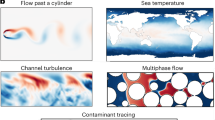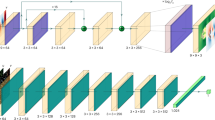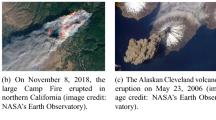Abstract
Achieving accurate and robust global situational awareness of a complex time-evolving field from a limited number of sensors has been a long-standing challenge. This reconstruction problem is especially difficult when sensors are sparsely positioned in a seemingly random or unorganized manner, which is often encountered in a range of scientific and engineering problems. Moreover, these sensors could be in motion and could become online or offline over time. The key leverage in addressing this scientific issue is the wealth of data accumulated from the sensors. As a solution to this problem, we propose a data-driven spatial field recovery technique founded on a structured grid-based deep-learning approach for arbitrary positioned sensors of any numbers. It should be noted that naive use of machine learning becomes prohibitively expensive for global field reconstruction and is furthermore not adaptable to an arbitrary number of sensors. In this work, we consider the use of Voronoi tessellation to obtain a structured-grid representation from sensor locations, enabling the computationally tractable use of convolutional neural networks. One of the central features of our method is its compatibility with deep learning-based super-resolution reconstruction techniques for structured sensor data that are established for image processing. The proposed reconstruction technique is demonstrated for unsteady wake flow, geophysical data and three-dimensional turbulence. The current framework is able to handle an arbitrary number of moving sensors and thereby overcomes a major limitation with existing reconstruction methods. Our technique opens a new pathway toward the practical use of neural networks for real-time global field estimation.
This is a preview of subscription content, access via your institution
Access options
Access Nature and 54 other Nature Portfolio journals
Get Nature+, our best-value online-access subscription
$29.99 / 30 days
cancel any time
Subscribe to this journal
Receive 12 digital issues and online access to articles
$119.00 per year
only $9.92 per issue
Buy this article
- Purchase on Springer Link
- Instant access to full article PDF
Prices may be subject to local taxes which are calculated during checkout






Similar content being viewed by others
Data availability
Training data used in this study are available on the Open Science Framework (https://doi.org/10.17605/OSF.IO/NKDZP).
Code availability
Sample codes for training our models are available on GitHub (https://github.com/kfukami/Voronoi-CNN and https://zenodo.org/badge/latestdoi/326312928).
References
Manohar, K., Brunton, B. W., Kutz, J. N. & Brunton, S. L. Data-driven sparse sensor placement for reconstruction: demonstrating the benefits of exploiting known patterns. IEEE Control Syst. Mag. 38, 63–86 (2018).
Akiyama, K. et al. First M87 event horizon telescope results. III. Data processing and calibration. Astrophys. J. Lett. 875, L3 (2019).
Alonso, M. T., López-Dekker, P. & Mallorquí, J. J. A novel strategy for radar imaging based on compressive sensing. IEEE Trans. Geosci. Remote Sens. 48, 4285–4295 (2010).
Mishra, K. V., Kruger, A. & Krajewski, W. F. Compressed sensing applied to weather radar. In 2014 IEEE Geoscience and Remote Sensing Symposium 1832–1835 (IEEE, 2014).
Fukami, K., Fukagata, K. & Taira, K. Assessment of supervised machine learning for fluid flows. Theor. Comp. Fluid Dyn. 34, 497–519 (2020).
Boisson, J. & Dubrulle, B. Three-dimensional magnetic field reconstruction in the VKS experiment through Galerkin transforms. New J. Phys. 13, 023037 (2011).
Noack, B. R. & Eckelmann, H. A global stability analysis of the steady and periodic cylinder wake. J. Fluid Mech. 270, 297–330 (1994).
Adrian, R. J. & Moin, P. Stochastic estimation of organized turbulent structure: homogeneous shear flow. J. Fluid Mech. 190, 531–559 (1988).
Suzuki, T. & Hasegawa, Y. Estimation of turbulent channel flow at Reτ = 100 based on the wall measurement using a simple sequential approach. J. Fluid Mech. 830, 760–796 (2006).
Bui-Thanh, T., Damodaran, M. & Willcox, K. Aerodynamic Data Reconstruction and Inverse Design Using Proper Orthogonal Decomposition 42 (AIAA, 2004).
LeCun, Y., Bengio, Y. & Hinton, G. Deep learning. Nature 521, 436–444 (2015).
Brunton, S. L., Noack, B. R. & Koumoutsakos, P. Machine learning for fluid mechanics. Annu. Rev. Fluid Mech. 52, 477–508 (2020).
LeCun, Y., Bottou, L., Bengio, Y. & Haffner, P. Gradient-based learning applied to document recognition. Proc. IEEE 86, 2278–2324 (1998).
Fukami, K., Fukagata, K. & Taira, K. Super-resolution reconstruction of turbulent flows with machine learning. J. Fluid Mech. 870, 106–120 (2019).
Rumelhart, D. E., Hinton, G. E. & Williams, R. J. Learning representations by back-propagation errors. Nature 322, 533—536 (1986).
Wu, Z. et al. A comprehensive survey on graph neural networks. IEEE Trans. Neural Netw. Learn. Syst. 32, 4–24 (2020).
Mallick, T., Balaprakash, P., Rask, E. & Macfarlane, J. Transfer learning with graph neural networks for short-term highway traffic forecasting. Preprint at https://arxiv.org/abs/2004.08038 (2020).
Chai, X. et al. Deep learning for irregularly and regularly missing data reconstruction. Sci. Rep. 10, 1–18 (2020).
Machicoane, N. et al. in Flowing Matter 177–209 (Springer, 2019).
Voronoi, G. New applications of continuous parameters to the theory of quadratic forms. First thesis on some properties of perfect positive quadratic forms. J. Reine Angew. Math. 133, 97–178 (1908).
Aurenhammer, F. Voronoi diagrams-a survey of a fundamental geometric data structure. ACM Comput. Surv. 23, 345–405 (1991).
Fukami, K., Fukagata, K. & Taira, K. Machine-learning-based spatio-temporal super resolution reconstruction of turbulent flows. J. Fluid Mech. 909, A9 (2021).
Nair, V. & Hinton, G. E. Rectified linear units improve restricted Boltzmann machines. Proc. 27th International Conference on Machine Learning 807–814 (2010).
Kingma, D. P. & Ba, J. Adam: a method for stochastic optimization. Preprint at https://arxiv.org/abs/1412.6980 (2014).
Prechelt, L. Automatic early stopping using cross validation: quantifying the criteria. Neural Netw. 11, 761–767 (1998).
Brunton, S. L. & Kutz, J. N. Data-driven Science and Engineering: Machine Learning, Dynamical Systems, and Control (Cambridge Univ. Press, 2019).
Taira, K. & Colonius, T. The immersed boundary method: a projection approach. J. Comput. Phys. 225, 2118–2137 (2007).
Colonius, T. & Taira, K. A fast immersed boundary method using a nullspace approach and multi-domain far-field boundary conditions. Comput. Methods Appl. Mech. Eng. 197, 2131–2146 (2008).
Fukagata, K., Kasagi, N. & Koumoutsakos, P. A theoretical prediction of friction drag reduction in turbulent flow by superhydrophobic surfaces. Phys. Fluids 18, 051703 (2006).
Fukami, K., Nabae, Y., Kawai, K. & Fukagata, K. Synthetic turbulent inflow generator using machine learning. Phys. Rev. Fluids 4, 064603 (2019).
Raissi, M., Perdikaris, P. & Karniadakis, G. E. Physics-informed neural networks: a deep learning framework for solving forward and inverse problems involving nonlinear partial differential equations. J. Comput. Phys. 378, 686–707 (2019).
Raissi, M., Yazdani, A. & Karniadakis, G. E. Hidden fluid mechanics: learning velocity and pressure fields from flow visualizations. Science 367, 1026–1030 (2020).
Hasegawa, K., Fukami, K., Murata, T. & Fukagata, K. Machine-learning-based reduced-order modeling for unsteady flows around bluff bodies of various shapes. Theor. Comput. Fluid Dyn. 34, 367–388 (2020).
Lee, S. & You, D. Data-driven prediction of unsteady flow fields over a circular cylinder using deep learning. J. Fluid Mech. 879, 217–254 (2019).
Du, Y. & Zaki, T. A. Evolutional deep neural network. Preprint at https://arxiv.org/abs/2103.09959 (2021).
Morimoto, M., Fukami, K., Zhang, K. & Fukagata, K. Generalization techniques of neural networks for fluid flow estimation. Preprint at https://arxiv.org/abs/2011.11911 (2020).
Hasegawa, K., Fukami, K., Murata, T. & Fukagata, K. CNN-LSTM based reduced order modeling of two-dimensional unsteady flows around a circular cylinder at different Reynolds numbers. Fluid Dyn. Res. 52, 065501 (2020).
Kim, H., Kim, J., Won, S. & Lee, C. Unsupervised deep learning for super-resolution reconstruction of turbulence. J. Fluid Mech. 910, A29 (2021).
Acknowledgements
R.M. and N.R. were supported by the U.S. Department of Energy, Office of Science, Office of Advanced Scientific Computing Research, under contract DE-AC02-06CH11357. This research was funded in part and used resources of the Argonne Leadership Computing Facility, which is a DOE Office of Science User Facility supported under contract DE-AC02-06CH11357. Koji.F. thanks support from the Japan Society for the Promotion of Science (grant nos. 18H03758, 21H05007). K.T. acknowledges support from the US Air Force Office of Scientific Research (grant nos. FA9550-16-1-0650 and FA9550-21-1-0178) and the US Army Research Office (grant no. W911NF-19-1-0032).
Author information
Authors and Affiliations
Contributions
Kai.F., R.M and N.R. designed research. Kai.F. performed research. Kai.F. analysed data. Kai.F. and K.T. wrote the paper. Koji.F. and K.T. supervised. All authors reviewed the manuscript.
Corresponding author
Ethics declarations
Competing interests
The authors declare no competing interests.
Additional information
Peer review information Nature Machine Intelligence thanks Mickaël Bourgoin and the other, anonymous, reviewer(s) for their contribution to the peer review of this work.
Publisher’s note Springer Nature remains neutral with regard to jurisdictional claims in published maps and institutional affiliations.
Extended data
Extended Data Fig. 1 Velocity RMS of turbulent channel flow.
Root mean squared value of streamwise velocity fluctuation in turbulent channel flow.
Rights and permissions
About this article
Cite this article
Fukami, K., Maulik, R., Ramachandra, N. et al. Global field reconstruction from sparse sensors with Voronoi tessellation-assisted deep learning. Nat Mach Intell 3, 945–951 (2021). https://doi.org/10.1038/s42256-021-00402-2
Received:
Accepted:
Published:
Issue Date:
DOI: https://doi.org/10.1038/s42256-021-00402-2
This article is cited by
-
Reconstructing Three-Dimensional Bluff Body Wake from Sectional Flow Fields with Convolutional Neural Networks
SN Computer Science (2024)
-
Reactor field reconstruction from sparse and movable sensors using Voronoi tessellation-assisted convolutional neural networks
Nuclear Science and Techniques (2024)
-
Uncertainty guided ensemble self-training for semi-supervised global field reconstruction
Complex & Intelligent Systems (2024)
-
Grasping extreme aerodynamics on a low-dimensional manifold
Nature Communications (2023)
-
The transformative potential of machine learning for experiments in fluid mechanics
Nature Reviews Physics (2023)



